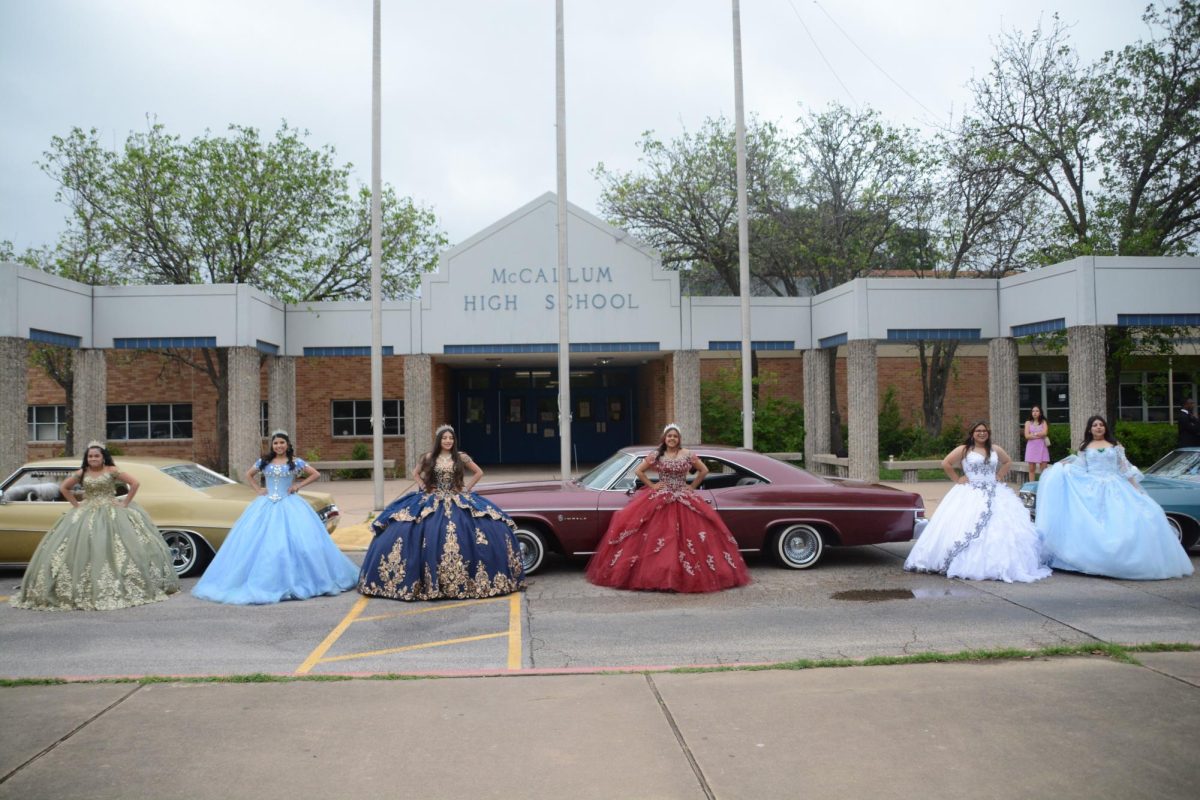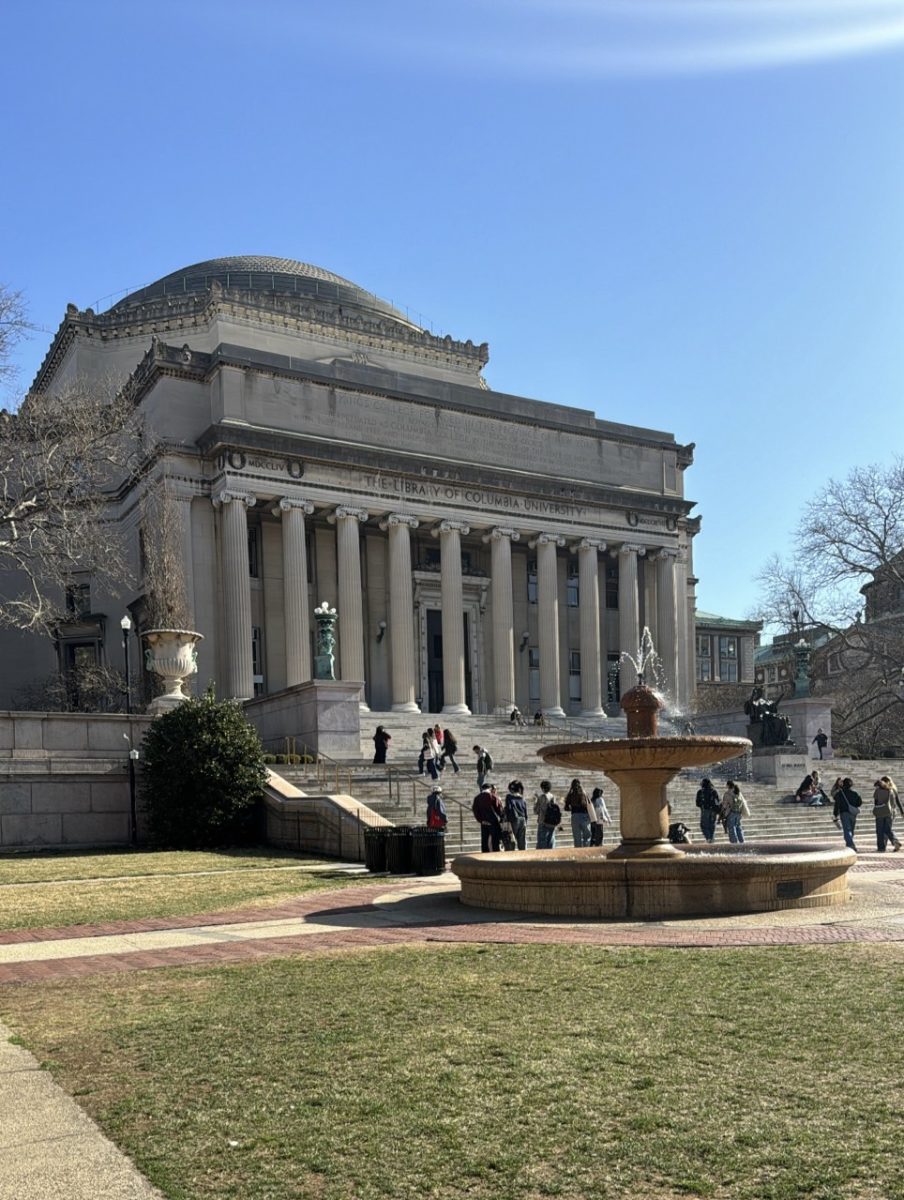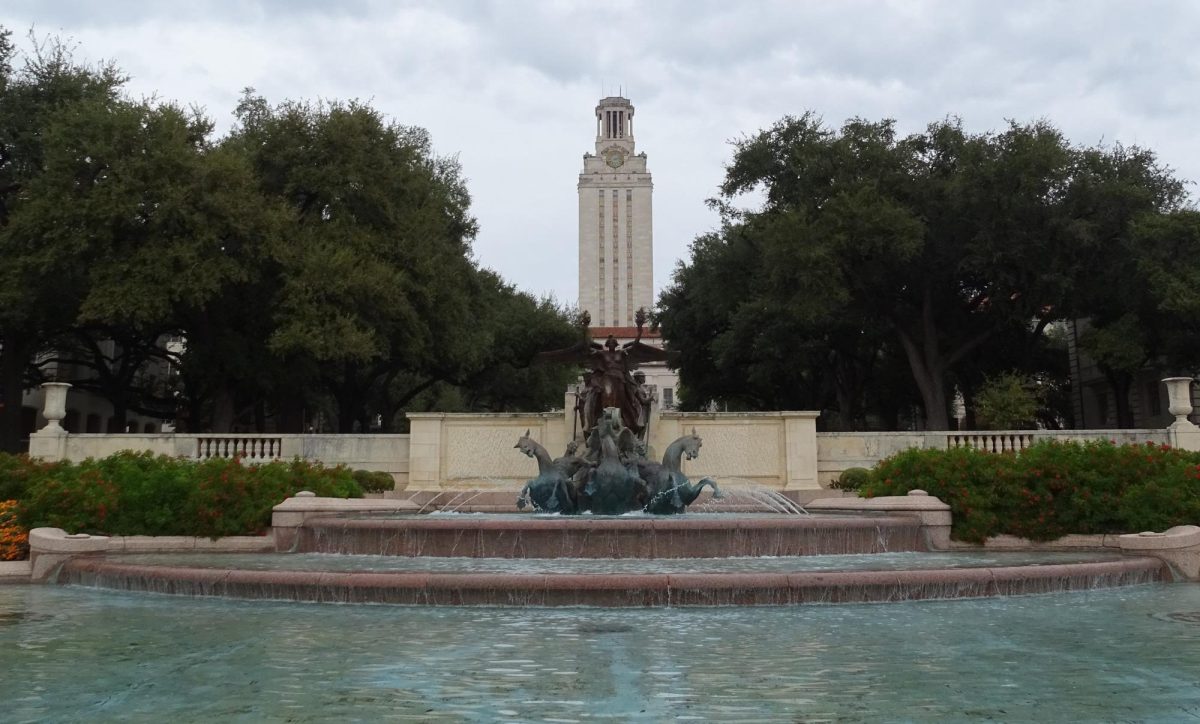With three Saturday sessions and a Sunday key note address, acclaimed photojournalist John Moore was the STAR attraction at this year’s Interscholastic League Press Conference Spring Convention at the University of Texas at Austin.
The 2005 Pulitzer Prize and 2019 World Press Photo of the Year winner spoke on many of his most dangerous and successful assignments: the U.S. invasion of Iraq, the later U.S. war on ISIS, the Ebola epidemic in Liberia, and undocumented immigration by Mexican and Central American asylum seekers across the entire length of U.S. border.
While the topics varied, Moore touched on many of the same themes in his sessions: the need for empathy, the importance of connecting with those you encounter and the critical importance of fairness and accuracy.
“The way to have longevity in his profession and not burn out is to believe and to make it happen that what we do matters,” Moore said. “We take pictures, we write stories: we affect the way that people around us feel. It’s an incredible privilege. Are there trolls? Are there critics? Yes, of course. That is the polarized society that we live in, but I don’t mind that. If criticism means that we take a few extra seconds to get the facts straight then maybe it’s done something good. If we do our work, and we’re passionate and we’re curious, and we believe that we can make a difference, sometimes you’ll just educate people and sometimes you’ll change public policy for the better.”
We are proud to share the lessons we learned from Moore as our #TuesdayTop10 photo essay this week. As an added bonus, we’ll include some film snippets from the closing moments of his Sunday morning keynote address at the LBJ Auditorum.
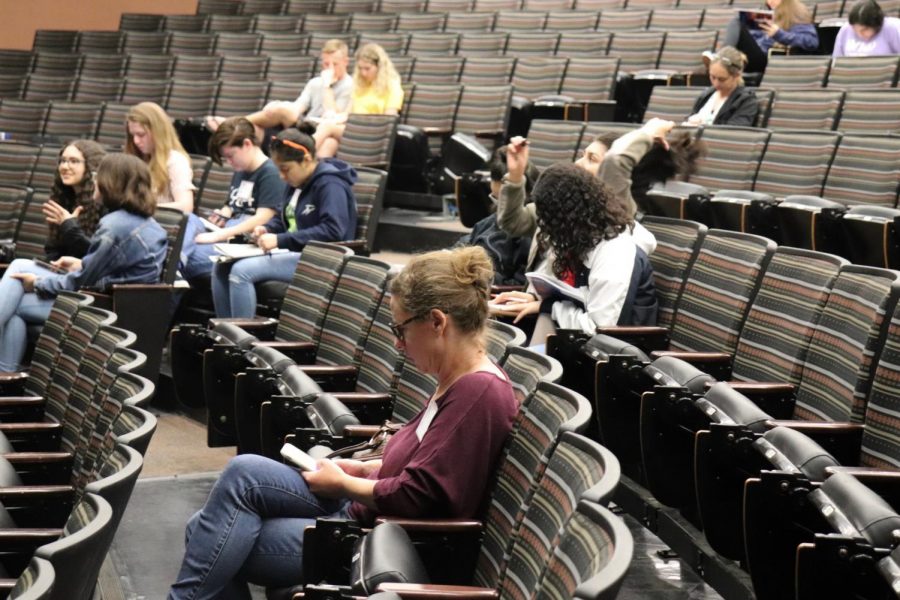
Students and advisors begin to fill in the lecture hall in anticipation to hear keynote speaker, John Moore, tell his intense and heart-wrenching tales of covering the Ebola outbreak in Liberia and the guerilla rebels on the frontline in Libya. Upon Moore’s arrival of the echoing hall, the audience fell silent. After introducing himself and giving a brief history of his work as a photojournalist, the lights were dimmed, and he began telling his story of becoming the first to travel to Liberia and cover the Ebola epidemic. Photo by Gabby Sherwood.
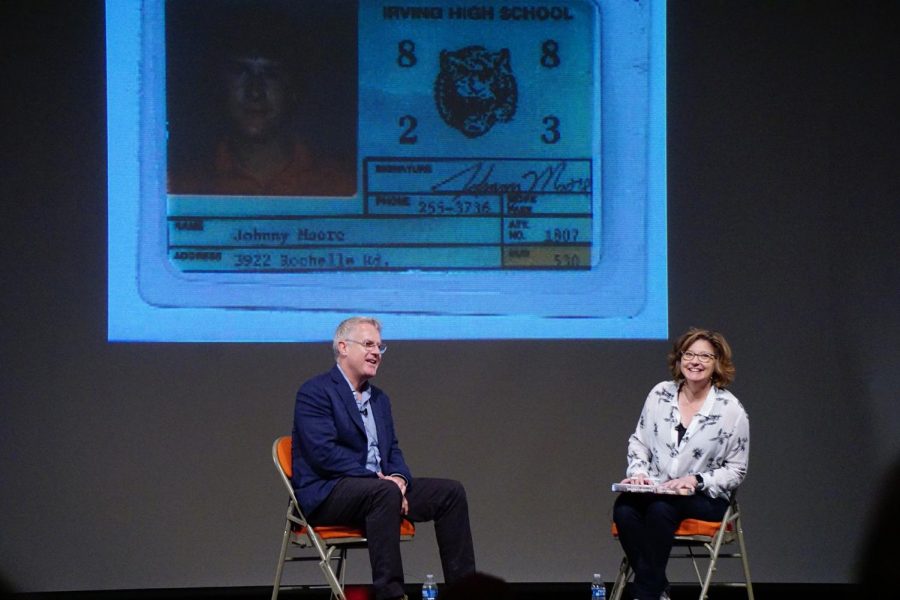
Keynote speaker and World Press Photo of the Year winner John Moore laughs with mediator Paula Adamek as he shows a picture of his first high school press pass. Moore talked at length about how his years in high school sparked and fostered his love of photojournalism. Moore held three breakout sessions in Burdine Hall on Saturday and a keynote address in the LBJ Auditorium Sunday. Photo by Caleb Melville.
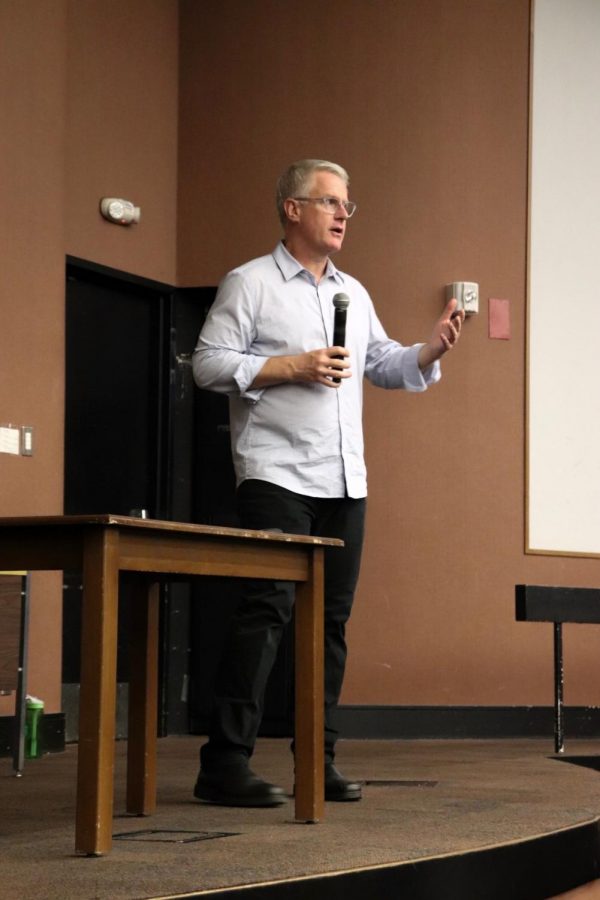
John Moore, a former UT photojournalist and current Getty Images special correspondent, shares his experiences from being the first photojournalist to cover the Ebola epidemic in Liberia. Back in 2014 when the epidemic had just begun spreading in the country of Liberia, Moore was drawn to the idea of going there, and began looking out for any information on the epidemic. “What I learned from researching the story, trying to figure out how to cover it, I learned it’s not airborne, it’s a waterborne disease” said Moore, “for healthcare workers it is very dangerous, but for a photographer, not so much.” After researching the disease, Moore had his heart set on Liberia, and convinced his bosses to let him cover it.When taking photos in Liberia, Moore was putting himself at risk by entering highly infected areas that the Ebola epidemic had overtaken. Working in the field required vast precaution and protection. “I had to wear a hazmat suit covering my entire body, two pairs of latex gloves, plastic covering that went over my shoes, and masks so my head was completely covered” said Moore, “the most important part was protecting my feet, because of any liquids on the infected ground”.As John Moore told his devastating stories of covering the epidemic, he showed a slideshow of photographs from his time in Liberia, of the people and children infected with Ebola. A wave of sadness fell over the audience as he showed heartbreaking photos of children dying, along with angry people protesting, believing Ebola was a hoax. “There was a lot of mistrust of government officials, people didn’t think Ebola was real, that it was just the government wanting to pull in foreign aid” said Moore, as he showed photos of locals facing off the military in the streets. Photo by Gabby Sherwood.
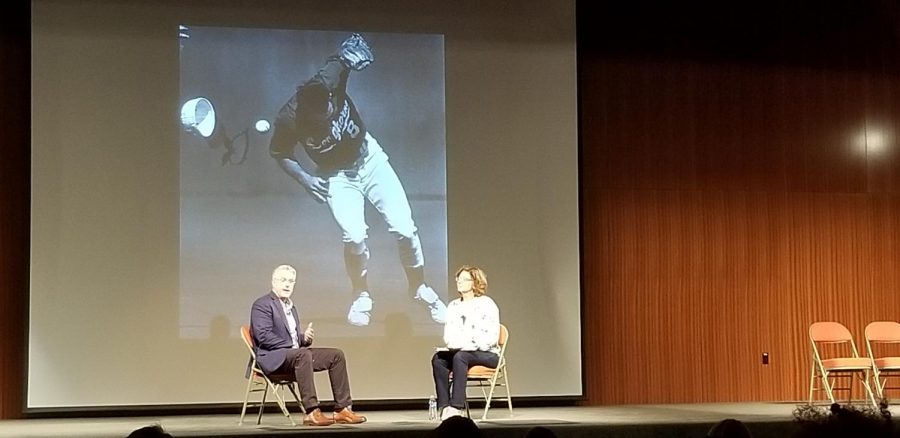
During the opening of Moore’s keynote speech on Sunday in the LBJ Auditorium, he shared images from his days as a high school photographer in Irvine and his college years at UT. This photo stood out to MacJournalism adviser Dave Winter because the photo took him back to his own days on The Daily Texan staff at UT. Winter was a general sports reporter covering the Longhorn baseball team and Moore’s photos would routinely run alongside Winter’s baseball stories. “It was a somewhat terrifying proposition,” Winter remembered. “I always tried to write the absolute best story I could because I was certain that everyone would see John’s picture and be amazed and then read my story and say, ‘Wow, great photo.’ I wanted my stories to read like they belonged next to his photos.” Moore joked during his Saturday afternoon session that his 11 semesters on the Texan staff was a longevity record that will never be broken. Photo by Dave Winter.
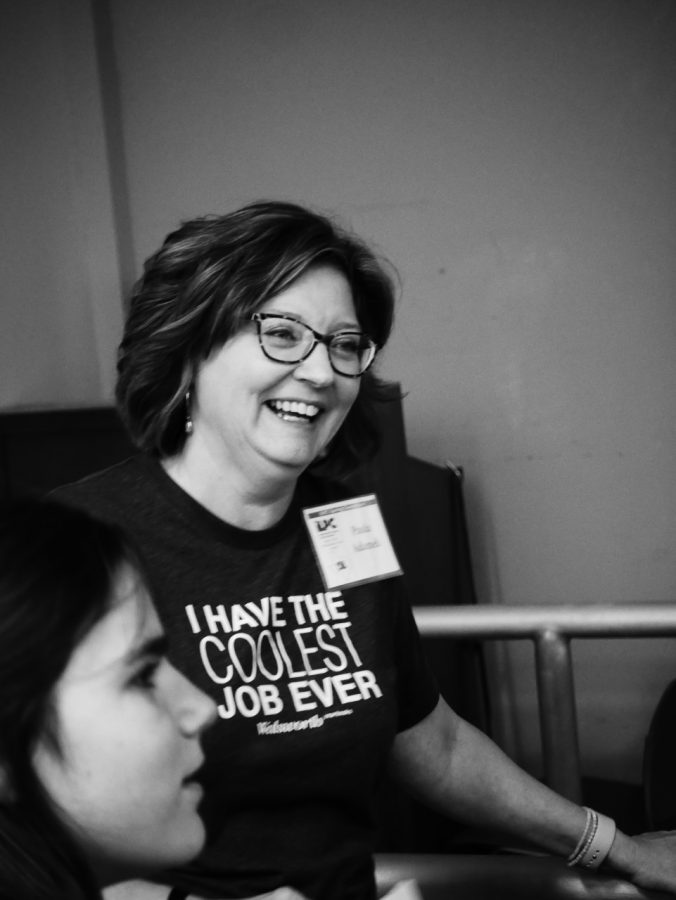
THE INS AND OUTS OF INDESIGN: Yearbook rep and session leader Paula Adamek lets out a laugh during her 2 p.m. presentation on shortcuts and design techniques to be used on the Adobe software, InDesign. “What I love about design is its ability to communicate to others,” Adamek said. “How we arrange the content is the vehicle for communication.” Adamek said it’s critically important that students educate themselves on software such as InDesign because it will help students further their careers in journalism. On Sunday morning, Adamek took on another prominent role at the convention when she facilitated Moore’s keynote by asking him question provided by audience members before the convention started. Photo and reporting by Stella Shenkman.

Internationally acclaimed photojournalist John Moore discusses how he got access to make some of his most stunning shots. Here he is telling a story of how he was able to befriend a border patrol pilot and get unprecedented access to shoot in Big Bend National Park. Moore talked about the importance of letting your subjects get to know that you will tell the story how it is, even if they don’t agree with all aspects of it. Photo by Caleb Melville.
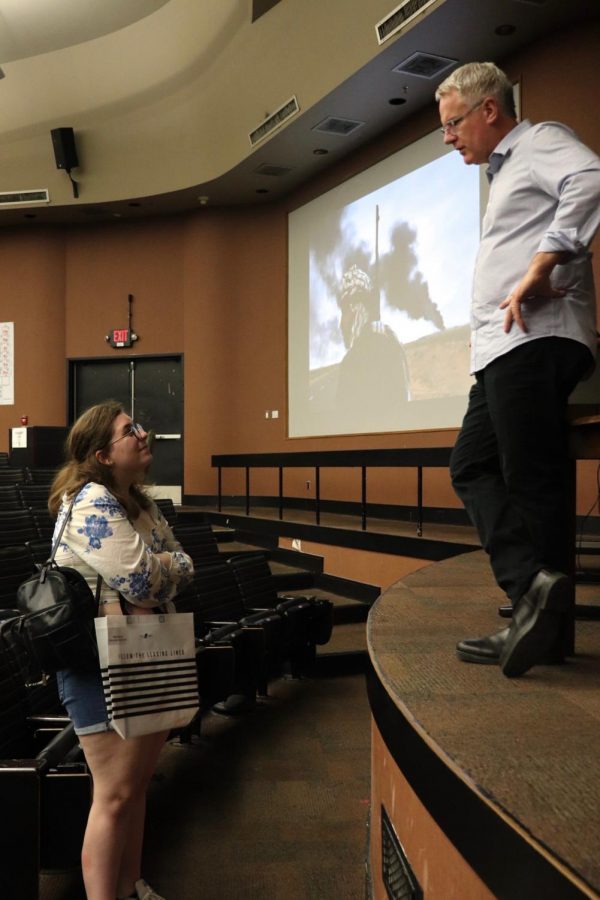
An eager and enthusiastic high school journalist keeps Moore engaged in conversation after the session had ended. The inspired student asked Moore to elaborate on the preparation he has to take to shoot in the dangerous places he does, and he first replied explaining how he always comes prepared with extra batteries and lenses for the camera. In the case of a dangerous situation, “I am always wearing a bulletproof vest and a helmet, I’m trying to take care of myself” Moore said. “We also always have a plan B, a hospital somewhere close, or a plan to evacuate if something goes wrong.” Moore recommended that this type of work is not safe for freelance photographers, because they do not have a backup in case they get hurt. The student then asked how he gets the information he does to tell stories behind his photos, which was responded with that Moore talks to the people he is photographing and builds relationships with them, and often his translator is translating for him. “How many languages do you speak?” the student asked, “I speak Spanish, and taxi conversation level Hindi and Arabic” Moore replied. After sessions is a great time for curious high school students to seek out more details about what they wish to learn, and this student seized that opportunity. Photo by Gabby Sherwood.
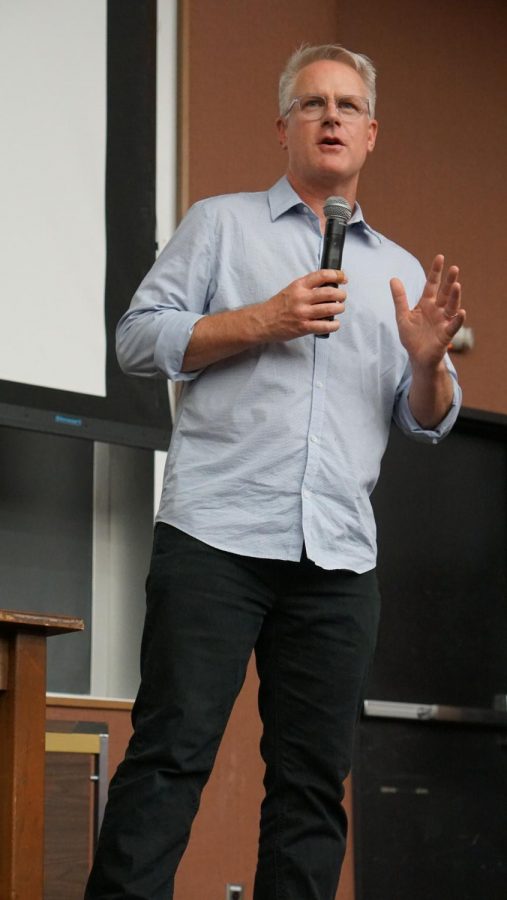
Before the start of his Saturday afternoon session about his book, Undocumented, Moore told his audience that he’d just booked international flights for his family using only frequent flier miles. He said the students might not appreciate the joy of free travel in this manner yet, but they would appreciate it when they get older. He said that he had been working on the project of documenting the process of asylum seekers for 10 years, but that it was an assignment not a book project until the November 2016 presidential election. He said the Trump’s election and his subject border security policies gave his work a new urgency. Photo by Dave Winter.
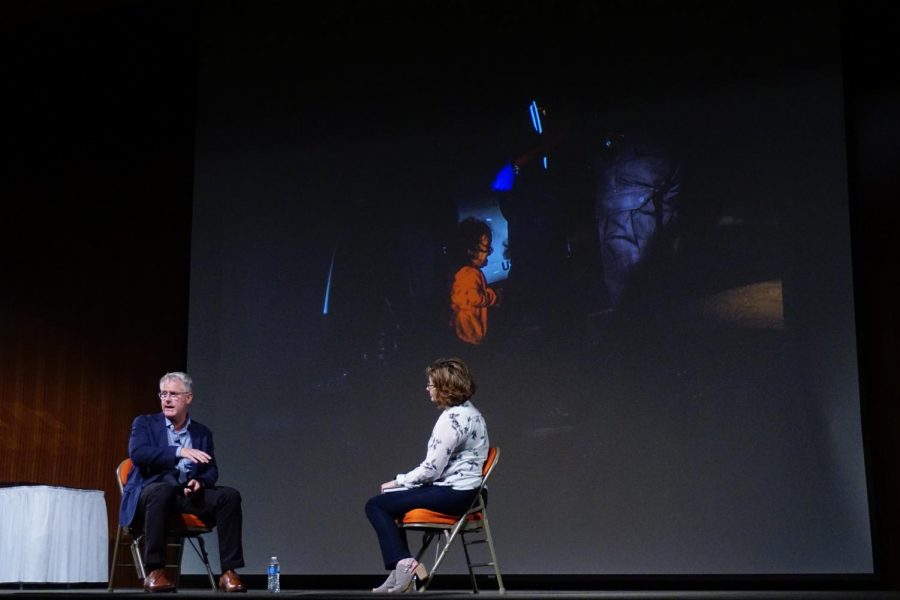
John Moore’s latest accomplishment in the photojournalism world, was winning the 2019 World Press Photo of the Year. His winning picture was part of a series of work on the undocumented crossings at the southern border and showed a young girl crying while her mother is detained by border patrol agents. Recounting the events that transpired, Moore said: “She [the border patrol agent] said ‘Look, you gotta set her down.’ and so when she set her daughter down, she immediately started to cry.” Moore has had some challenges with this photo being taken out of context after he captured the image and wrote the original caption for it. TIME magazine cut out the image of the girl and used part of the photo in a misleading way. The actual story behind the photo is that the family was being taken, together to a processing center and if they were to be separated was unknown. In his talk, Moore stressed how important it is to have the full story behind a photograph before making assumptions. Photo by Caleb Melville.
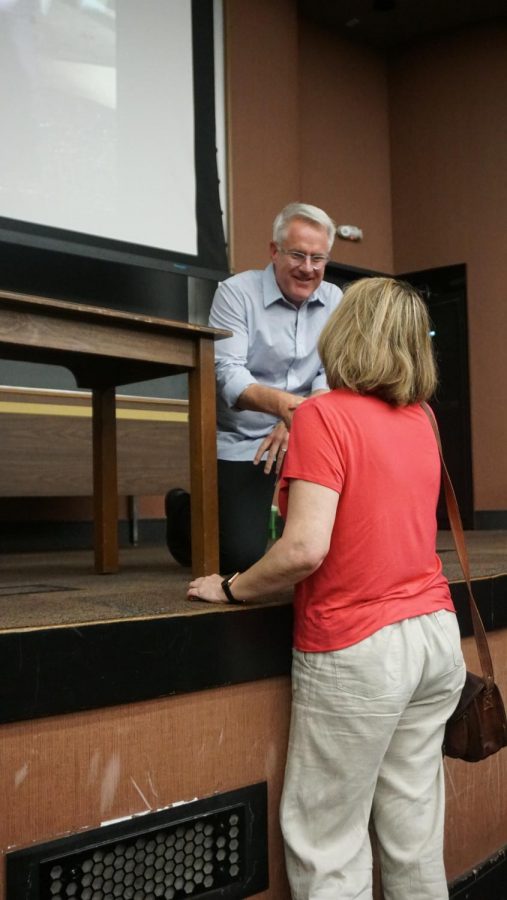
Moore greets an audience members after his Saturday afternoon session in Burdine Hall. Moore stressed repeatedly that the way you treat people is at least as important as how you master the technical aspects of taking pictures. Because he followed through on a promise to send photos to a pilot, the pilot later went out of his way to fly Moore over Big Bend where he took a gorgeous overhead shot that shows the majesty of the Rio Grande in a way no other perspective could capture. Photo by Dave Winter.
Photojournalist John Moore on the role of the photojournalist at the 2019 ILPC Convention Keynote Address on May 5 in the LBJ Auditorium.
Photojournalist John Moore discusses how he captured “Crying Girl on the Border” and how the image went viral as it became an iconic representation of President Trump’s immigration policies. The image was captured on June 12 near McAllen, Texas. The comments were part of his keynote address at the ILPC convention at the LBJ Auditorium on the University of Texas campus on May 5.
Photojournalist John Moore discusses balancing work and family in his closing comments during his keynote address at the ILPC journalism convention at the LBJ Auditorium on the University of Texas campus on May 5.



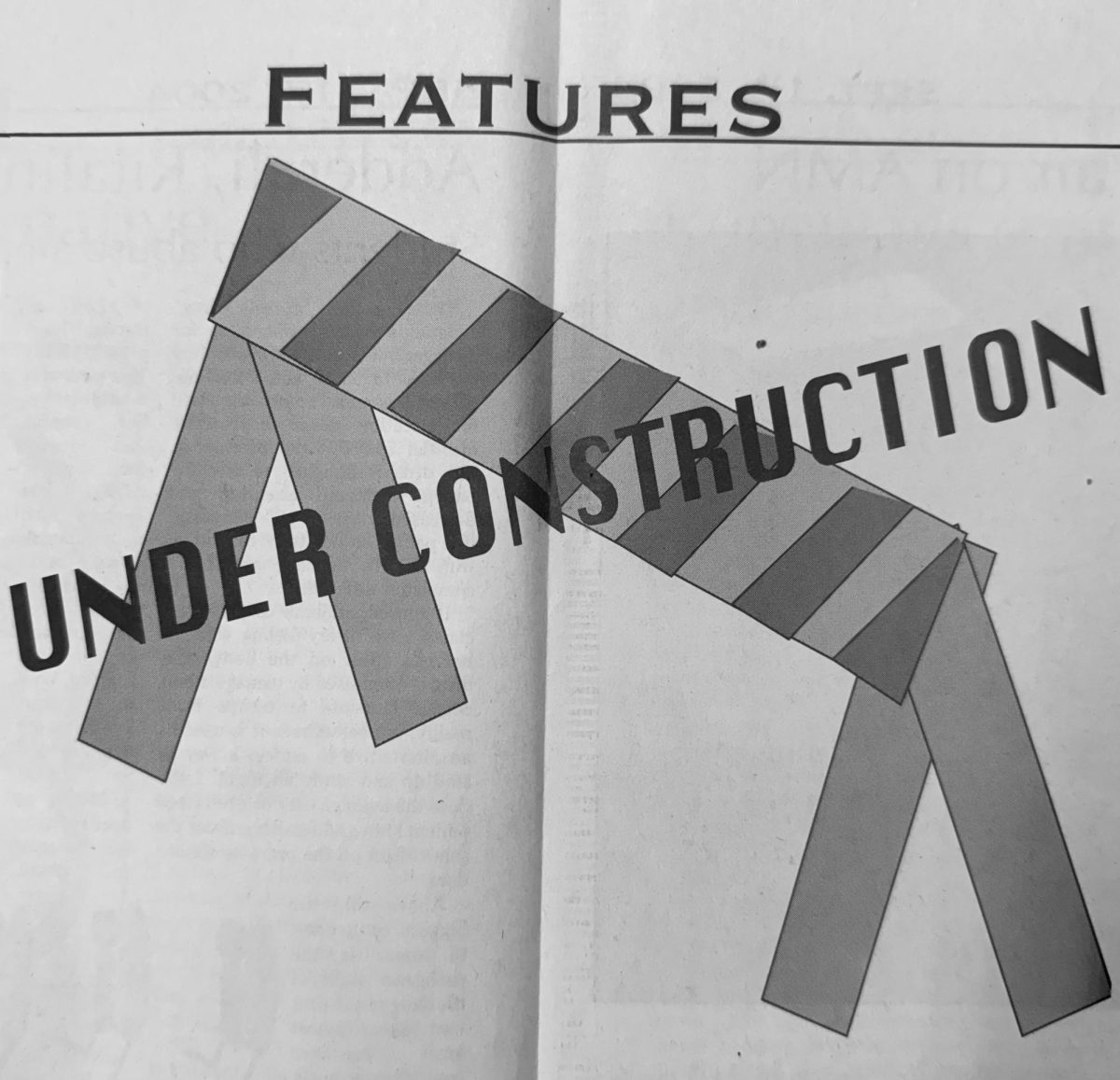
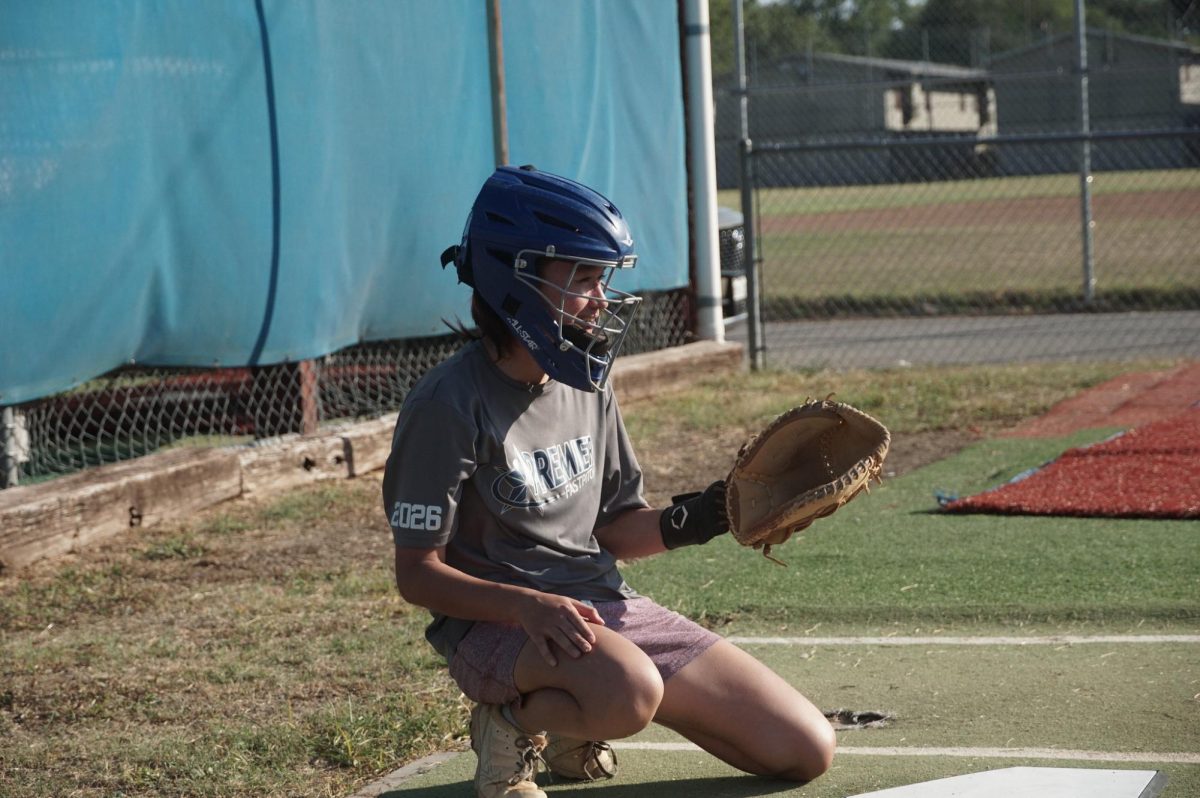
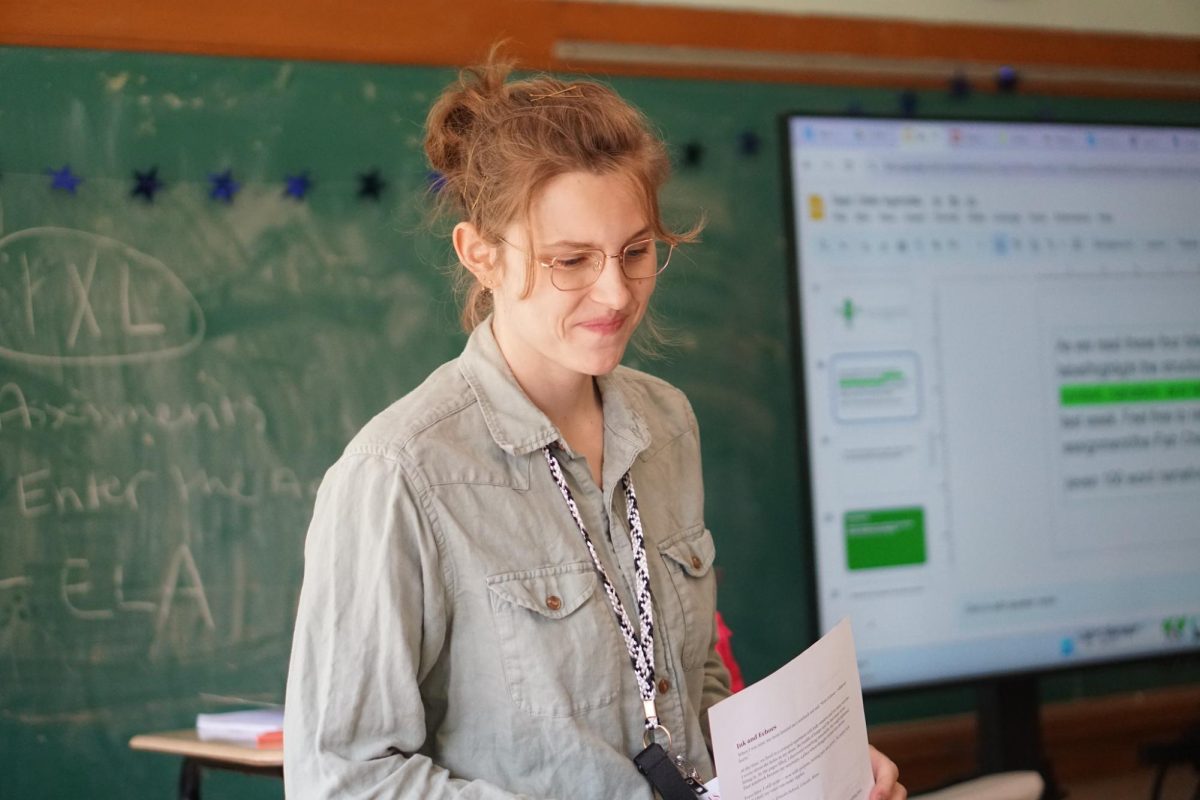

![ONE LAST BATTLE CRY: Senior Valeria Villafuerte-Perez celebrates with her friends after the senior class won the spirit competition. At each pep rally, a different game is played with volunteers from the crowd. Villafuerte-Perez was nominated by her friends to play a game in which the goal was to snatch a pom-pom from an opponent.
“Before school started, my friends and I had talked about going all out for senior year, so I told them to nominate me for a game since it was our last [Shoal Creek Showdown] pep rally,” Villafuerte-Perez said. “I wasn’t really scared to go down to the floor in front of the whole school, all I was focused on was getting the crowd hyped for the game.”
Villafuerte-Perez entered the game determined to win. After several rounds, as there were just two people left, she managed to snatch the last pom just in time, in order to secure a victory for the senior class.
“I was really happy I won the game for the class of 2026,” Villafuerte-Perez said. “Honestly, I just wanted to win because seniors rule.”
As this was her first pep rally as a senior, the event carried extra meaning to Villafuerte-Perez.
“Being in the stands as a senior feels very surreal,” Villafuerte-Perez said. “I still remember my first pep rally, and now I’m a senior having my last pep rally, I think in that moment it really set in that I’m a senior, and that I’m going to graduate soon.”
Caption by Sophia Manos. Photo by Julia Copas.](https://macshieldonline.com/wp-content/uploads/2025/09/54750679693_5f7d007e27_o-1200x675.jpg)
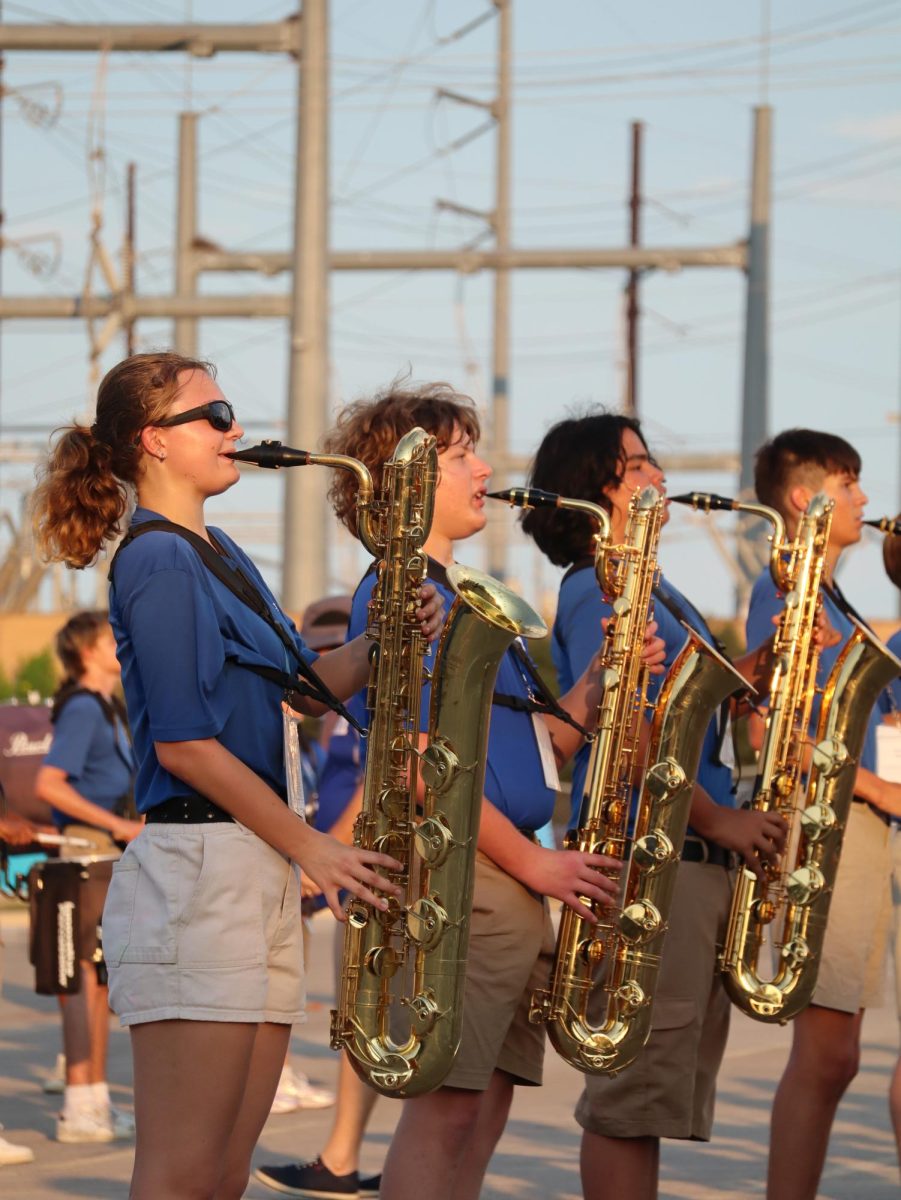


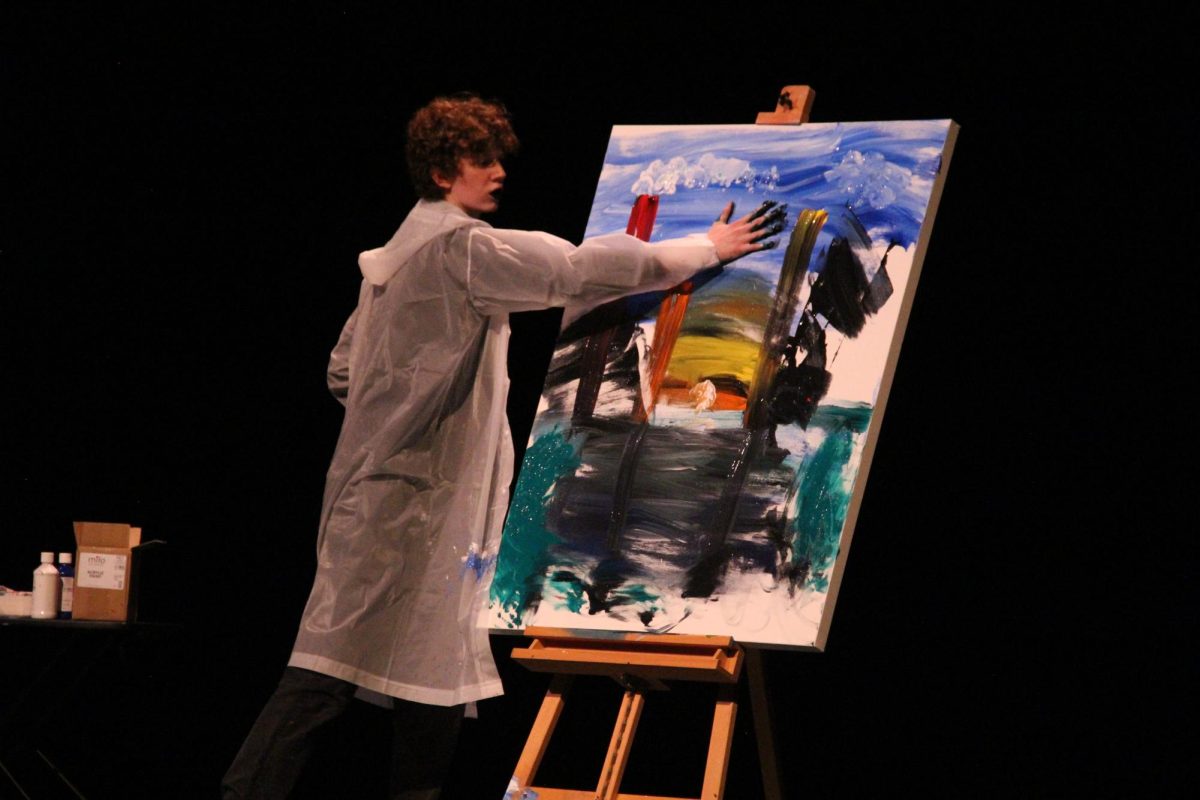
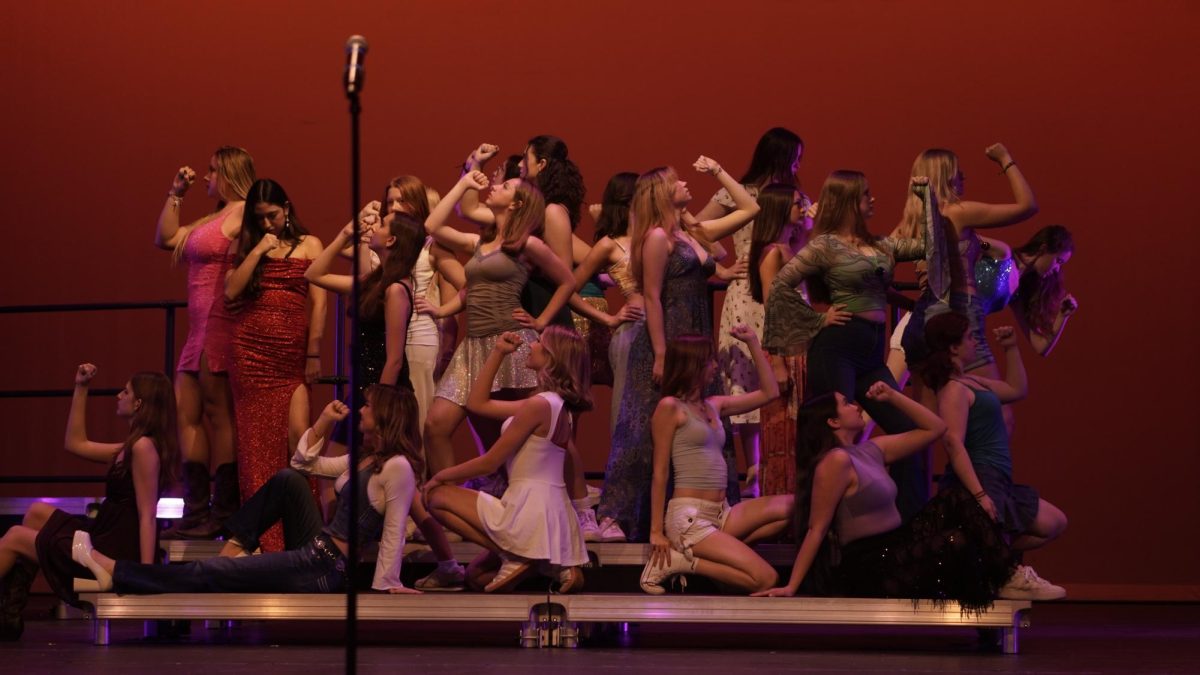

![WORKING TOGETHER: McCallum Dance Company performs the student-choreographed “Dancing with Death” during last Tuesday’s dress rehearsal before the spring dance show. Sophomore Pia Sosa performed in five different numbers during the show and thought that everything went well even despite a few challenges.
“I was getting a little worried closer to the end because there were still a lot of changes happening and people getting shuffled around into places,” Sosa said. “But by the tech week and by the shows, it really felt like we all worked together and came together.”
Sosa’s favorite part was performing “Come Play,” which was choreographed by junior Maya Tien. Sosa loved being able to work with Tien because of her level of preparation and being able to perform hip hop, since the dance company does not perform that style as much.
“It’s the first number I do in the show, and I always just felt like it gave me so much energy,” Sosa said. “It felt really good because we rarely do hip hop, so it just felt like such a great opportunity to do something that I don’t get to do all the time.”
Sosa explained that there were some challenges due to sudden changes in several pieces, however Sosa said she was proud of how the company responded as a whole.
“Everybody put their best foot forward and pushed through any challenges that they were having,” Sosa said. “I’m really proud of how the company handled it all.”
Overall, Sosa said she is grateful for all the work put in by the dance directors and the student choreographers for producing the show.
“We couldn’t have put the show together without [them],” Sosa said. “Mac dance is amazing and I can’t wait to choreograph next year.”
Caption by Riley Pita. Photo by Harper Maxwell.](https://macshieldonline.com/wp-content/uploads/2025/04/54471134934_215f07dcfb_o_54485123147_o-1-1200x800.jpg)


